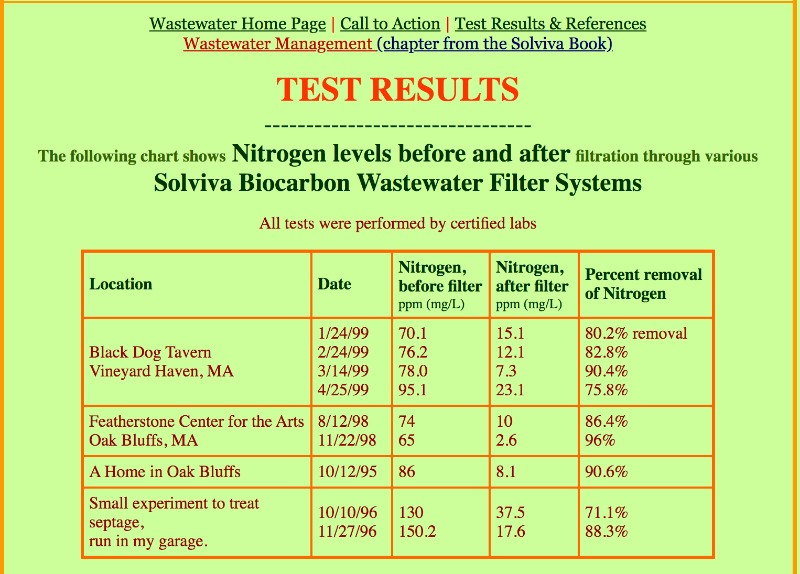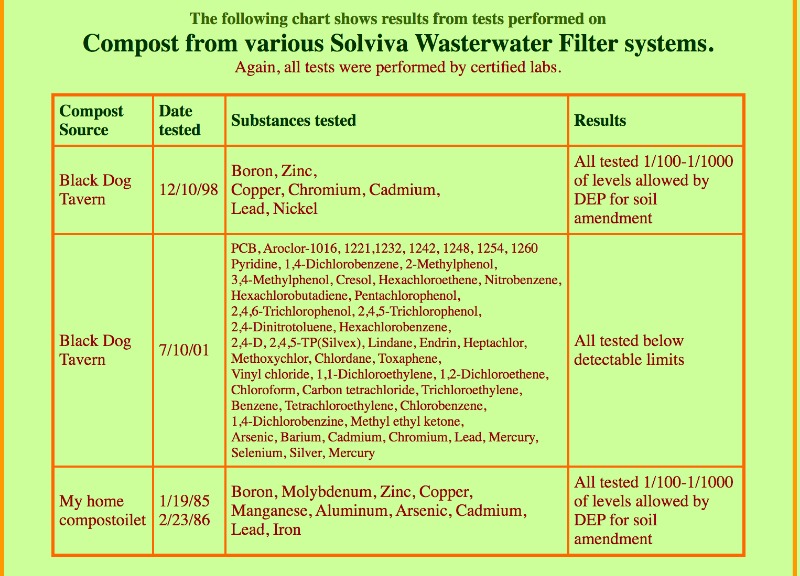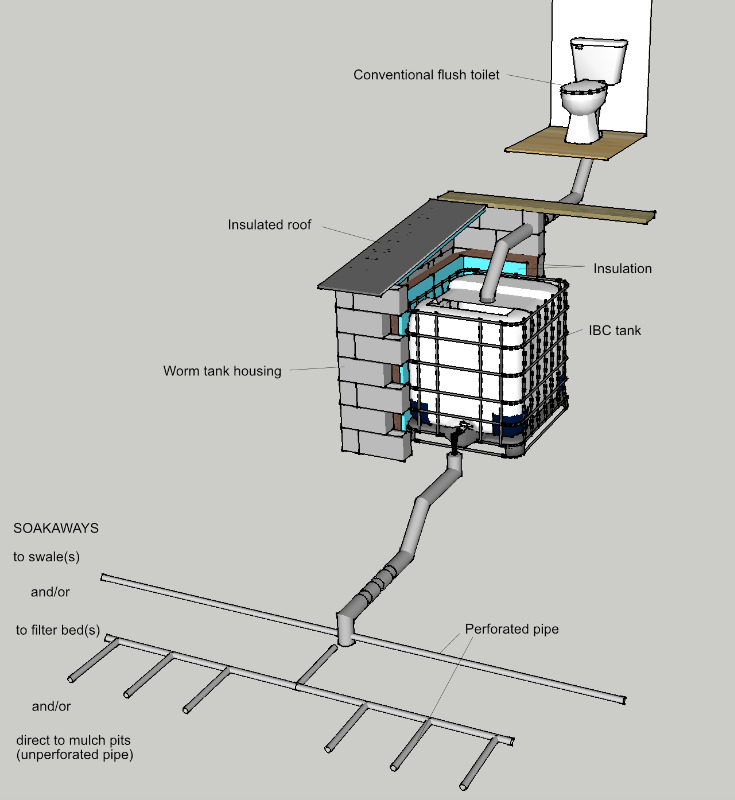- Resource recovery
- Vermitechnology
- Vermifilters for blackwater treatment, "worm toilets", "Tiger worm toilet"
- I developed an open source composting / vermicomposting toilet design based on an ordinary flush toilet
I developed an open source composting / vermicomposting toilet design based on an ordinary flush toilet
26.8k views
- WendyHoward
-
 Topic Author
Topic Author- Biologist/ecologist/educator running a permaculture centre in Central Portugal. Came across vermicomposting/vermifiltration in waste management in 2013 and developed an open-source DIY system based on one pioneered by Anna Edey in the 1990s and using conventional flush toilets. Passionate about restoring life and health to the planet's ecosystems.
Again, not easy to empty those big translucent tanks. I think what you're saying is you could have it pumped out if you needed to empty it. It would be difficult to empty any solids.
Pumped?! You can't pump solid material! This is an aerobic composting process which consumes material rather than needing to be emptied. At least over the 7 years I've had it running. I see no signs to indicate that process will alter its fundamental dynamics anytime soon. Should I want to use some of the compost, it's easy enough to dig out.
Facebook - www.facebook.com/QtadoVale/
Websites - www.permaculturinginportugal.net/
www.vermicompostingtoilets.net/
Please Log in to join the conversation.
You need to login to reply- Ecowaters
-
 Less
Less- Posts: 62
- Karma: 1
- Likes received: 9
She had a below-ground tank with shallow leachate system. These are allowed in Massachusetts, as they are a variation of several systems. (However, since she had a legal septic system in place, she's mostly allowed to do what she wants.) She has worms in hers. Like many septic tanks that aren't super-loaded, it likely hasn't been pumped out in a long while.
There were several changes in her house, as Martha's Vineyard residents often rent out all or parts of their homes thanks to the lucrative rental market. She explained to us why and how she changed her system, which changed her wastewater systems.
A below-ground tank with worms in it is not especially new. The design she has is related to other systems in place in her state due to onsite wastewater regulations that were made stricter in 1995. She is guessing at the nitrogen reduction percentage, however, I'm sure it is much more sound than a conventional system. This is a big issue in coastal Massachusetts.
Again, not easy to empty those big translucent tanks. I think what you're saying is you could have it pumped out if you needed to empty it. It would be difficult to empty any solids.
None of this is to say that these systems don't work. There are many variations of these out there. Some have no more evidence of worms but still work very well if they are aerated and/or vented---because that contributes to success more than worms.
carol-steinfeld.com (personal)
www.ecotoilets.org (soon)
ecotechproducts.net
Please Log in to join the conversation.
You need to login to reply- WendyHoward
-
 Topic Author
Topic Author- Biologist/ecologist/educator running a permaculture centre in Central Portugal. Came across vermicomposting/vermifiltration in waste management in 2013 and developed an open-source DIY system based on one pioneered by Anna Edey in the 1990s and using conventional flush toilets. Passionate about restoring life and health to the planet's ecosystems.
You might go visit Anna Edey's system. I lived nearby on the mainland and visited there. The system folks usually talk about was dismantled years ago. What she emphasizes is using a shallow rootzone distribution system for leachate. The system you see in her book from the 1990s was no longer there. She had a simple urine-div system with bucket in place for her own use.
That';s not the case according to Anna Edey herself, who wrote on my site in 2015 "I’ve now had mine going constantly for more than 20 years without any odors, flies, clogging, freeze-up or other problems – it is reducing nitrogen pollution into the groundwater by better than 90%."
Or according to this post , written a year later.
Or are you talking purely about the 'greenfilter' element of her system? In which case, a shallow root zone distribution system is exactly what's being used in my adaptation of her system.
What you say about the tank needing actively aerated, emptied and the timescales involved does not match with my experience at all. The organic material in the tank is both substrate and feedstock for the ecosystem, so it's consumed. Far from needing emptied, the tank needs to be regularly topped up with fresh organic material. Active aeration is not necessary.
My system has been going for 7 years now and has never needed emptying. It handles the waste of between 1 and 6 people on a regular basis, depending on the number of people staying onsite at any time, and occasional short-term peaks of up to 20. The ecosystem survived the wildfires which destroyed the house it was attached to and half burnt the tank. All we had to do was transfer the contents to a fresh tank (not particularly difficult since a hatch is cut into the top of the tank to allow easy access for organic material additions, monitoring and maintenance).
A number of others locally have adopted the system so we are building up a body of experience. We are finding that it's important to have a good mix of carbon sources, including some relatively chunky wood waste. The latter keeps the substrate well aerated as well as providing a matrix for the microbiology to inhabit. Where people have relied too heavily on dried leaves for their organic material additions, occasional problems have been encountered with the water getting hung up in the tank fairly high up. The leaves, once wet, stick together and form a mat which acts like a membrane, preventing easy flow of water through the system. In most cases, the problem is easily solved by perforating and mixing the upper layer, adding some fresh dry organic material, and letting the system rest for a few days while the worms deal with the backlog of waste.
It's important to emphasise that this is a living system which requires monitoring, care and maintenance to ensure optimum conditions are maintained. However the maintenance is far less than for most dry systems. 7 years on I remain very happy with it and am about to build 2 more to cope with increased visitor numbers to the site.
Facebook - www.facebook.com/QtadoVale/
Websites - www.permaculturinginportugal.net/
www.vermicompostingtoilets.net/
Please Log in to join the conversation.
You need to login to reply- Ecowaters
-
 Less
Less- Posts: 62
- Karma: 1
- Likes received: 9
There are some misunderstandings among people who read about it but have never seen it.
About the large translucent 250-gallon tanks, I find the people who try them end up abandoning them because they are too difficult to empty.
I know some people are promoting these for event use, some with the assertion that they won't have to be emptied for a decade. However, when I talk to their hired help, I hear a different story about how long they've been in use and when they were last emptied.
It's true that two people using one with leachate drainage and active aeration might not see it fill for 5 years+. But when it does, it will be interesting to empty it.....
The worms will stay happy as long as they can escape from the urine. We see this in all composting toilets.
carol-steinfeld.com (personal)
www.ecotoilets.org (soon)
ecotechproducts.net
Please Log in to join the conversation.
You need to login to reply- WendyHoward
-
 Topic Author
Topic Author- Biologist/ecologist/educator running a permaculture centre in Central Portugal. Came across vermicomposting/vermifiltration in waste management in 2013 and developed an open-source DIY system based on one pioneered by Anna Edey in the 1990s and using conventional flush toilets. Passionate about restoring life and health to the planet's ecosystems.
Re: Which composting toilet to choose - recommendations, please?
Excuse me for butting in, but are you not aware that the pathogens are lethal? Why would you want to spread them around?
Pathogens are lethal?! That's a complete nonsense without qualification! A bit like saying humans are lethal.
That statement is utterly meaningless without reference to context and circumstances.
You can only say that some pathogens have the potential to be lethal in certain contexts. Context is everything. Disease is always multifactorial. A pathogen which can produce a fatal outcome in one context can be benign in another. Nothing in any living system acts in isolation.
Given that context is everything, it then becomes necessary to study the detail of the pathways and interactions which lead to various different outcomes. Having done so, you can then devise effective management strategies. So yes, I trust the microbiology thank you very much. There's nothing magical going on here.
Facebook - www.facebook.com/QtadoVale/
Websites - www.permaculturinginportugal.net/
www.vermicompostingtoilets.net/
Please Log in to join the conversation.
You need to login to reply- joeturner
-
 Less
Less- Posts: 717
- Karma: 23
- Likes received: 185
Re: Which composting toilet to choose - recommendations, please?
WendyHoward wrote: My thoughts?
My first thought was to try and get my head around your way of thinking to understand where you're coming from and why you appear to be so aggressively fearful about human faecal waste entering the environment. The impression I get from what you wrote is that human faeces are something to be handled in much the same way as nuclear waste. And that bacteria in general are something to be feared. I have difficulty understanding this attitude so perhaps you'd like to explain?
Excuse me for butting in, but are you not aware that the pathogens are lethal? Why would you want to spread them around?
Would you eat cheese that had been started with lethal microbes and went through zero microbiological testing before it arrived on your plate?
Would you rather trust magic or microbiology?
Please Log in to join the conversation.
You need to login to reply- WendyHoward
-
 Topic Author
Topic Author- Biologist/ecologist/educator running a permaculture centre in Central Portugal. Came across vermicomposting/vermifiltration in waste management in 2013 and developed an open-source DIY system based on one pioneered by Anna Edey in the 1990s and using conventional flush toilets. Passionate about restoring life and health to the planet's ecosystems.
Re: Which composting toilet to choose - recommendations, please?
My first thought was to try and get my head around your way of thinking to understand where you're coming from and why you appear to be so aggressively fearful about human faecal waste entering the environment. The impression I get from what you wrote is that human faeces are something to be handled in much the same way as nuclear waste. And that bacteria in general are something to be feared. I have difficulty understanding this attitude so perhaps you'd like to explain?
Mammalian faeces are not designed to be decomposed in water or any other anaerobic environment. The human digestive tract is an anaerobic environment. Pathogens which thrive in this environment will thrive to a far greater extent if you maintain anaerobic conditions after they leave the body. What better way to do that than to drop them into water? Further, the rate of decomposition in an anaerobic environment is so slow that accumulation rates frequently exceed decomposition rates so septic tanks have to be emptied and the contents otherwise disposed of, so I agree with you that septic tanks are a less than optimum system.
Like all mammalian species, humans evolved as part of an interdependent natural system to contribute to pedogenesis by adding our faeces to the top layers of the soil. The soil is precisely where a huge diversity of organisms exist (in healthy soil at least ...) who have evolved over millennia for exactly this purpose. If you want to deal sustainably and naturally with faecal pathogens, then there is no better place than the soil to find the organisms to do it.
This is part of a natural process and, as such, is far superior in design to anything humans can come up with. Not least for the fact that it's been tested and refined over literally millions of years ...
What is contained in these worm tanks (and other similar systems) is the soil ecosystem on steroids. And on steroids because we are providing optimum conditions - comfortable temperature range, optimum moisture levels, aerobic environment, plentiful supplies of organic material, a large number of "microbe nurseries" (worms), and a system depth many times greater than the average depth of the detritus layer in soils - for it to operate at maximum efficiency.
Which is what it needs to do. Because what is 'unnatural' about the system - and any system of human waste management - is the constant deposition of faecal material in the same location.
By replicating the same system in the secondary processing area (albeit more open so without as great a level of optimisation), you are again providing the conditions to ensure you're maximising opportunities for pathogens to be dealt with by the soil biota. Which - given the extent of degradation of soils and soil biology brought about by our catastrophic lack of understanding of soil ecology - is these days pretty essential.
As for the water used in the system, it's only a temporary carrier medium and the volumes involved are very small. The system is, and remains aerobic. That water has ample opportunity to be acted on by the biota it has to pass through. Consider this: if upwards of 90% of nitrates can be removed by the bacteria present in the primary processing tank from solution in a throughput time of as little as 10 minutes, you can be confident similar dynamics are applying to any water-borne pathogens.
These are some of the reasons why, as a biologist/ecologist, I was excited to find Anna Edey's system and continue her work.
So perhaps you'd like to explain your thinking in turn?
Facebook - www.facebook.com/QtadoVale/
Websites - www.permaculturinginportugal.net/
www.vermicompostingtoilets.net/
Please Log in to join the conversation.
You need to login to reply- HarryTams
-
Less
- Posts: 31
- Likes received: 14
Re: Which composting toilet to choose - recommendations, please?
Laboratory test results speak for themselves if there has been due diligence when taking samples. Are there other substances that one should also test?
Kai, It would be good to get data from local sewage treatment plants. How would they compare with the data Wendy has provided?
Please Log in to join the conversation.
You need to login to replyRe: Which composting toilet to choose - recommendations, please?
Considering one (1) gram of wet feces contains ~100 billion bacteria (among numerous other pathogenic organisms) and that your system is designed to pass feces-contaminated liquid through quickly (thus minimizing the amount of time which microbes might otherwise have to digest/render safe pathogens) then I'm still unsure about the safety of your system as presented.
Also, FWIW I don't much care that your local council approved the design - they approve septic tanks, sewers and centralized wastewater treatment plants all the time too, even in full light of the fact that they are woefully inadequate, failure prone and destructive (given that they rely on the long outmoded "dilution solution", require heavy inputs of energy and contaminate otherwise "clean water).
Your thoughts?
Founding Member of Water-Wise Vermont (formerly Vermonters Against Toxic Sludge)
Please Log in to join the conversation.
You need to login to reply- WendyHoward
-
 Topic Author
Topic Author- Biologist/ecologist/educator running a permaculture centre in Central Portugal. Came across vermicomposting/vermifiltration in waste management in 2013 and developed an open-source DIY system based on one pioneered by Anna Edey in the 1990s and using conventional flush toilets. Passionate about restoring life and health to the planet's ecosystems.
Re: Which composting toilet to choose - recommendations, please?
I think you're seriously missing something. Did you read through the site and how the system works? There is an entire ecosystem in that tank processing the waste. I hardly think the environmental engineers at my local council - some of whom specialise in sanitation systems - would have approved this system for use and commissioned an installation to replace a failed septic tank if it didn't do what it's supposed to do! Or that several proprietary systems would exist on the market at present based on very similar principles.
This system is based on Anna Edey's original development of the 1990s which she had extensive testing done on and showed the system to remove upwards of 90% of all pollutant measures in a throughput time of as little as 10 minutes. No trace of any pathogens were detected in testing.
Most of the serious pathogens which develop in association with effluent do so because the effluent is in an anaerobic context - usually suspended in water for considerable periods of time. Here, with the processing taking place onsite, the amount of time faecal material is immersed in water is a matter of seconds - the time it takes to travel from the toilet to the tank. The system in the tank is aerobic and remains so under normal operating conditions. Processing time for the worms to deal with the solids is usually less than a week.
My original secondary processing area (the 'greenfilter') was designed to show up any nutrient making it through the primary processing area. After 7 years of operation now, there is no evidence at all.
Anna Edey's original site no longer exists, but these are her test results ...
Facebook - www.facebook.com/QtadoVale/
Websites - www.permaculturinginportugal.net/
www.vermicompostingtoilets.net/
Attachments:
-
 annaedey1.jpg
(Filesize: 116KB)
annaedey1.jpg
(Filesize: 116KB)
-
 annaedey2.jpg
(Filesize: 136KB)
annaedey2.jpg
(Filesize: 136KB)
Please Log in to join the conversation.
You need to login to replyRe: Which composting toilet to choose - recommendations, please?
[Source: www.vermicompostingtoilets.net/wp-conten.../complete-system.jpg]
I ask because there doesn't appear to be any allowance for preventing the constant input of fresh pathogen rich material nor a method for preventing it from contaminating the abundant volume (thanks to the pedestal toilet being a standard flush-type) of effluent produced - the latter of which is then permitted to freely contaminate soil and, no doubt in practice, groundwater. I view this flawed design as little more than another in the long line of, to borrow a term popularized by Joe Turner, "magic black box" toiletry - a fatally flawed sanitation system which does far more harm than good.
Or am I missing something?
Founding Member of Water-Wise Vermont (formerly Vermonters Against Toxic Sludge)
Attachments:
-
 complete-system.jpg
(Filesize: 95KB)
complete-system.jpg
(Filesize: 95KB)
Please Log in to join the conversation.
You need to login to reply- WendyHoward
-
 Topic Author
Topic Author- Biologist/ecologist/educator running a permaculture centre in Central Portugal. Came across vermicomposting/vermifiltration in waste management in 2013 and developed an open-source DIY system based on one pioneered by Anna Edey in the 1990s and using conventional flush toilets. Passionate about restoring life and health to the planet's ecosystems.
Full details are on my website .
The website also has a section on the history of the development of this system.
Please note for whoever wrote the Wikipedia article that neither Anna Edey's nor my system ever need emptying. In at least 15 years of continuous operation, Anna Edey has never emptied her system .
These vermicomposting ecosystems are based in a wholly organic substrate. Not only do the worms also process the organic material (as they would in the normal process of soil formation), the entire ecosystem makes use of the carbon contained in it to process nitrates, etc, in the waste. This means that far from needing emptying, the system must be topped up from time to time with more organic material.
Facebook - www.facebook.com/QtadoVale/
Websites - www.permaculturinginportugal.net/
www.vermicompostingtoilets.net/
Please Log in to join the conversation.
You need to login to reply- Resource recovery
- Vermitechnology
- Vermifilters for blackwater treatment, "worm toilets", "Tiger worm toilet"
- I developed an open source composting / vermicomposting toilet design based on an ordinary flush toilet







